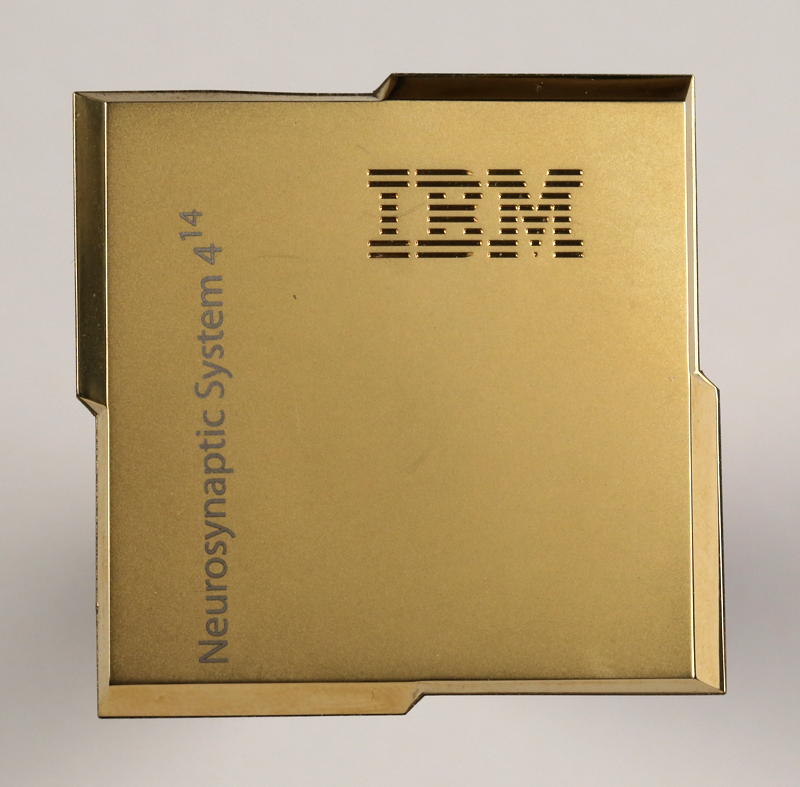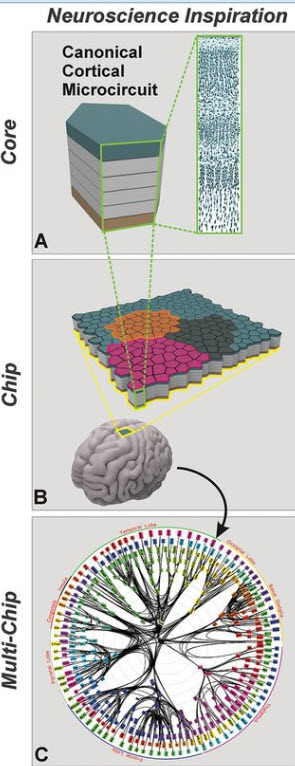IBM launches functioning brain-inspired chip
August 7, 2014

IBM neurosynaptic chip (credit: IBM)
IBM announced today, August 7, the first computer chip to achieve one million programmable “neurons,” 256 million programmable “synapses,” and 46 billion “synaptic operations” per second per watt — simulating the function of neurons and synapses in the brain.*
Neurosynaptic. At 5.4 billion transistors, this low-power, production-scale “neurosynaptic” (brain-inspired) chip (the size of a postage stamp), is one of the largest CMOS chips ever built, IBM says. Yet running at biological real time, it consumes only a minuscule 70mW.
That’s orders of magnitude less power than a modern microprocessor and the energy equivalent of a hearing-aid battery.
It has a power density of 20mW/cm2 — nearly four orders of magnitude less than today’s microprocessors, says IBM. The trick: the new chip is event-driven — it operates only when it needs to, resulting in a cooler operating environment and lower energy use.

(Credit: IBM)
Non-von Neumann. This radical new cognitive chip architecture is also a departure from the classical von Neumann architecture — the basis of almost every computer today — which inherently creates a bottleneck limiting performance of the system.
Instead, the new “TrueNorth” chip architecture features an digital on-chip, two-dimensional mesh network of 4096 digital, distributed neurosynaptic cores.
Each core module integrates memory, computation, and communication, and operates in an event-driven, parallel, and fault-tolerant fashion.
Transforming mobility. To demonstrate scalability, IBM also revealed a 16-chip system with sixteen million programmable neurons and four billion programmable synapses.
“These brain-inspired chips could transform mobility, via sensory and intelligent applications that can fit in the palm of your hand but without the need for Wi-Fi,” said Dr. Dharmendra S. Modha, IBM Fellow and IBM Chief Scientist, Brain-Inspired Computing, IBM Research.
Goal: 100 trillion synapses. IBM says it is planning to integrate its neurosynaptic processing into mobile devices to overcome limitations constrained by power, volume and speed.
IBM also visualizes real-time multimedia cloud services, a power-efficent supercomputer based on these chips, and neurosynaptic supercomputers that would eventually scale to 100 trillion synapses (the estimated number in the human brain) and beyond.
Modha’s team imagines several interesting practical applications for the power-efficient chips, calling on their potential visual-recognition and other brain-like algorithms.

Auditory cues for the blind (Credit: IBM)
A blind person, for example, could receive auditory cues to avoid objects in her path.
And a basketball-like device called “Tumbleweed” could navigate inside a dangerous environment (such as a nuclear reactor) and send back radiation and other data.
The Defense Advanced Research Projects Agency (DARPA) has funded the project since 2008 with approximately $53M via its Systems of Neuromorphic Adaptive Plastic Scalable Electronics (SyNAPSE) program. Current collaborators include Cornell Tech and iniLabs, Ltd.
* KurzweilAI has reported on previous theoretical and prototype versions of this chip, as noted in “related” below.